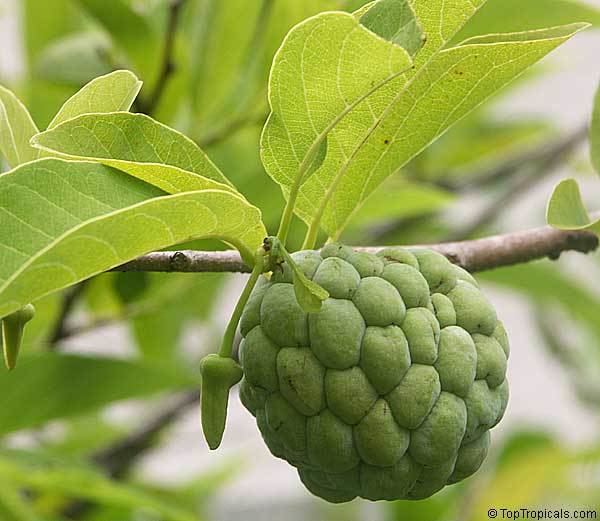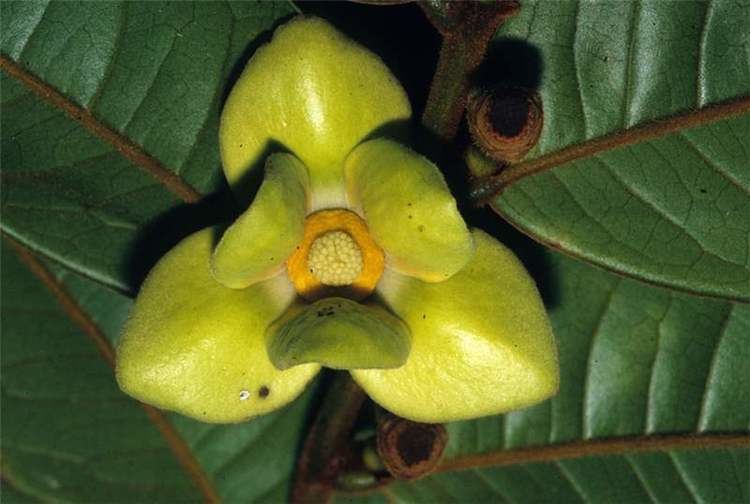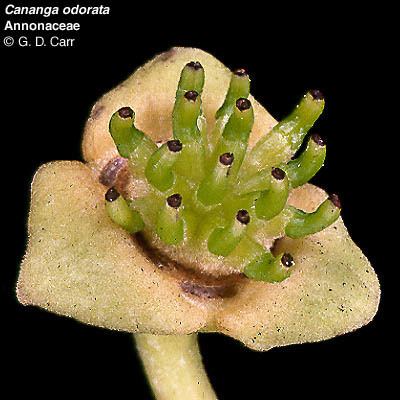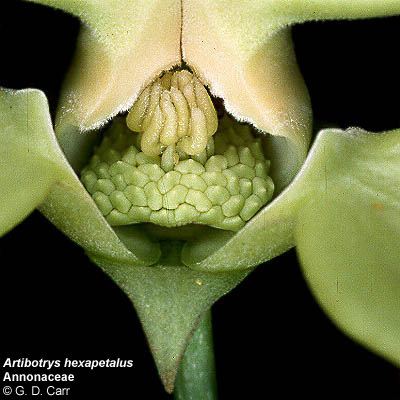Scientific name Annonaceae | ||
 | ||
Lower classifications | ||
The Annonaceae are a family, the custard apple family, of flowering plants consisting of trees, shrubs, or rarely lianas. With 108 accepted genera and about 2400 known species, it is the largest family in the Magnoliales. Several genera produce edible fruit, most notably Annona, Anonidium, Asimina, Rollinia, and Uvaria. Its type genus is Annona. The family is concentrated in the tropics, with few species found in temperate regions. About 900 species are Neotropical, 450 are Afrotropical, and the other species Indomalayan.
Contents
- Annonaceae
- Description
- Systematics
- Food
- Folk medicine
- Toxicology
- Other uses
- Other
- Chemical constituents
- References

Annonaceae
Description

The species are mostly tropical, some are mid-latitude, deciduous or evergreen trees and shrubs, with some lianas, with aromatic bark, leaves, and flowers.


Systematics
Monophyly and inter-familial systematics have been well supported for Annonaceae by a combination of morphological and molecular evidence. The APG II system places Annonaceae as most closely related to the small Magnoliid family Eupomatiaceae.
In a phylogeny-based reclassification of the family four subfamilies are recognised: Anaxagoreoideae (including just Anaxagorea), Ambavioideae, Annonoideae, and Malmeoideae. A number of the larger genera, including Guatteria, with its 177 species, Annona, and Xylopia belong to Annonoideae. Together, Annonoideae and Malmeoideae comprise the majority of the species and each are further subdivided into a number of tribes. The subfamilial and tribal classification is followed in World Annonaceae which presents an overview of all Annonaceae genera and taxonomic, distribution and photographic information for a large number of species. Keys for the identification of Annonaceae genera (separately for Neotropical, African/Madagascan, and Asian/Australian taxa) are presented in . For a concise bibliographic overview of the taxonomic literature (1900 to 2012) see.
Both plastid DNA markers and morphological characters provide evidence that Anaxagorea is the sister clade to the rest of the family. This may confirm the hypothesis that morphological traits shared between Anaxagorea and other Magnoliales species (such as 2-ranked phyllotaxis, monosulcate pollen, and laminate stamens) represent ancestral characters, while derived characters observed in other genera have evolved independently multiple times. The oldest fossil evidence of Annonaceae is described as the genus Futabanthus, from the late Cretaceous of Japan, which represents a minimum age of c. 89 Mya for the most recent common ancestor (crown group) of the family. The ages of Annonaceae clades inferred using fossil evidence and molecular clock based dating techniques suggests that the pantropical distribution of the family originated subsequent to the break up of the Gondwanan supercontinent, as the result of a combination of geodispersal tracking the expansion of the boreotropical flora during the Eocene and more recent long distance dispersal events.
Food
The large, edible, pulpy fruits of some members typically called anona by Spanish- and Portuguese-speaking people of the family's Neotropical range, include species of Annona: custard apple (A. reticulata), cherimoya (A. cherimola), soursop/guanábana/graviola (A. muricata), sweetsop (A. squamosa), ilama (A. diversifolia), soncoya (A. purpurea), atemoya (a cross between A. cherimola and A. squamosa); and biriba (Rollinia deliciosa, which may require reclassification under Annona.). The names of many of those fruits are sometimes used interchangeably. Recently, consumption of the neotropical annonaceous plant Annona muricata (soursop, graviola, guanabana) has been strongly associated as a causal agent in "atypical Parkinsonism". The causative agent, annonacin, is present in many of the Annonaceae. It is thought to be responsible for up to 70% of Parkinsonian conditions in Guadeloupe. Exposure is typically through traditional food and natural medicines.
Asimina triloba (American pawpaw, prairie banana) has an Eastern U.S. distribution, and is currently under investigation as a commercial agricultural crop.
Folk medicine
The bark, leaves, and roots of some species are used in folk medicines.
Toxicology
The compound annonacin in the seeds and leaves of many Annonaceae including Annona muricata (soursop), is a neurotoxin and it seems to be the cause of a neurodegenerative disease. The disorder is a so-called tauopathy associated with a pathologic accumulation of tau protein in the brain. Experimental results demonstrate that the plant neurotoxin annonacin is responsible for this accumulation.
Other uses
Lancewood (Oxandra lanceolata) is a tough, elastic, and heavy wood obtained from the West Indies and The Guianas. It was often used for carriage shafts. It is brought into commerce in the form of taper poles of about 6 m in length and from 15 to 20 cm in breadth at the butt. The black lancewood or carisiri of The Guianas is of remarkably slender form.
The yellow lancewood tree Calycophyllum candididissimum, common names lemonwood or degame, is from a different family (Rubiaceae). It is used as an alternative to lancewood and is found in tolerable abundance throughout The Guianas, and used by the Amerinds for arrow-points, as well as for spars, beams, etc. Some bowyers use this wood for making longbows.
Other
Chemical constituents
A large number of chemical compounds, including flavonoids, alkaloids, and acetogenins, have been extracted from the seeds and many other parts of these plants. Flavonoids and alkaloids contained in the leaves and bark of several species of the family have shown insecticidal properties.
